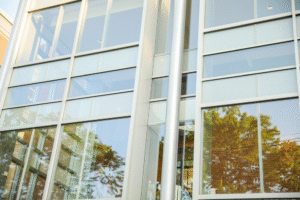
The last time we walked into a halfway-done project, the issue wasn’t the layout or the materials. It was the windows. More specifically, the lack of energy-efficient window certifications.
The original team had selected models without verified performance ratings, and that one oversight derailed everything. HVAC loads went off target. The building failed its energy inspection. The owner had to redo specs, delay occupancy, and burn through budget to fix a choice that could’ve been solved with a better label.
We’ve seen this story play out more times than we’d like to count. And if you’re leading commercial projects, you’ve probably felt it too: the pressure to get it right, the risk of oversights and the hidden cost of products that look good but underdeliver.
That’s why energy-efficient window certifications are so essential. Energy Star, NFRC ratings, LEED — each one tells you something different. But unless you know how to read them (and which ones your project actually needs), you leave performance, compliance, and cost-efficiency to chance.
This guide explores how to evaluate energy-efficient window certifications like a pro, spec confidently, and avoid the kind of mistake that turns into an expensive lesson.
What are energy-efficient window certifications?
They’re not just stickers on glass and they’re definitely not created equal.
Energy-efficient window certifications are third-party validations that a meets specific thermal, solar, and air leakage standards. Most people see the logo, assume it’s “good enough,” and move on, without ever looking at what the numbers behind that label actually mean for the building.
That’s where problems start.
A window with poor U-Factor ratings can throw off your entire mechanical plan. One with a low SHGC in a cold climate might reduce passive solar gain and increase heating demands. And if you’re bidding on LEED-certified projects, the wrong selection can disqualify your contribution entirely.
These certifications exist to eliminate that kind of uncertainty. They give you hard data to spec with accuracy, and help ensure that the products you choose deliver on energy performance, sustainability targets, and building code compliance.
They’re essentially performance insurance.
Key energy-efficient window certifications that matter
Here’s what matters — and what each certification reveals that brochures don’t.
Energy Star®
The most recognized label, Energy Star, is a federal program backed by the Environmental Protection Agency (EPA) and the Department of Energy (DOE). It doesn’t test the windows, but it sets performance thresholds that products must meet based on climate zones across the U.S.
A window earns the label if its NFRC ratings (more on those next) fall within the Energy Star-approved range for its designated region. That includes acceptable limits for:
- U-Factor (insulation performance)
- Solar Heat Gain Coefficient (SHGC) (solar radiation control)
However, a window that qualifies for Energy Star in one region might fail in another. That’s why it’s not enough to see the logo, you need to check the zone-specific qualification map to ensure alignment with your project’s location.
NFRC (National Fenestration Rating Council)
NFRC is the independent third-party that tests and certifies window and door performance. Their label provides detailed numeric values, not just a pass/fail stamp. These are the numbers inspectors, energy modelers, and mechanical engineers look for.
Every NFRC-certified window or door includes:
- U-Factor: Measures how well the product insulates. Lower = better.
- SHGC (Solar Heat Gain Coefficient): Measures how much solar heat passes through. Depends on the climate.
- VT (Visible Transmittance): The amount of visible light transmitted. Higher = brighter interiors.
- Air Leakage (AL): Optional rating, but crucial for energy modeling. Lower = less draft.
This label gives you the actual performance metrics to match mechanical loads, energy targets, and code compliance.
LEED (Leadership in Energy and Environmental Design)
LEED, created by the U.S. Green Building Council (USGBC), rates the sustainability of buildings. Doors and windows contribute to LEED in multiple categories:
- Energy & Atmosphere (EA): Certified windows improve thermal performance scores.
- Indoor Environmental Quality (EQ): High-VT glass can support daylighting credits.
- Materials & Resources (MR): Using regionally sourced or recyclable components adds value.
Products with Energy Star or NFRC labels don’t get you LEED points directly, but they help your building meet the performance requirements that do.
Regional and State-Level Certifications
National compliance doesn’t guarantee local approval.
Some states have their own sets of efficiency standards that go beyond Energy Star. Some require:
- Specific U-Factor or SHGC limits
- Mandatory low-emissivity (Low-E) glass
- Air infiltration ratings below certain thresholds
Skipping this check leads to failed inspections, redesigns, and delays. Always confirm with your local energy code or AHJ (Authority Having Jurisdiction).
These energy-efficient window certifications, when properly understood, protect your budget, your timeline, and your reputation.
Why energy-efficient window certifications pay off

Here’s what they deliver:
Better Energy Performance = Lower Operating Costs
When you choose products with validated U-Factor and SHGC values, you improve insulation and reduce the demand on mechanical systems. That means:
- Smaller HVAC equipment
- Less runtime
- Fewer maintenance issues
- Real monthly savings
Easier Compliance with Energy Codes and Inspections
Passing inspection in commercial projects is non-negotiable. Using certified products makes the process smoother, faster, and more predictable:
- Inspectors recognize and trust Energy Star and NFRC labels
- Certified specs align with most local and state energy codes
- You avoid red flags, rework, and project delays
When the product is verified, your design is validated.
LEED and Sustainability Benefits
Energy-efficient window certifications directly contribute if your client wants a LEED rating or needs to meet ESG (Environmental, Social, Governance) targets:
- Improve energy modeling scores
- Enable daylighting strategies
- Support sustainable sourcing and low-emission criteria
Being able to say your build uses certified components sells your project to tenants, investors, and regulators.
Risk Reduction for Everyone Involved
Certified means tested. And tested means predictable. That reduces:
- Warranty claims
- Post-occupancy complaints
- Legal exposure for underperformance
It also protects your reputation. Because no one remembers that the façade was pretty if the energy bill tripled.
Certified products pay off in energy savings, in smoother approvals, reduced risks, and higher-performing projects.
How to Verify a Product’s energy-efficient window certifications
Not all labels are legitimate. Trusting the wrong one can mean code violations, project delays, and a hit to your credibility.
Here’s how to make sure the product delivers what it claims.
Check the Manufacturer’s NFRC Label
Every certified window or door should have a physical NFRC label attached to it at the time of delivery. This label isn’t just branding — it’s a breakdown of critical performance metrics:
- U-Factor
- SHGC
- Visible Transmittance (VT)
- Optional: Air Leakage (AL)
If the label isn’t there, that’s a red flag. If it’s there, cross-check it with the NFRC Product Directory.
QR codes on NFRC labels often link directly to the official database, if they don’t, verify manually at nfrc.org.
Use the Energy Star Certified Products List
The Energy Star website lets you verify if a product is truly certified for your climate zone. Input the manufacturer, model, and region, and you’ll get a simple yes/no result. If it’s not listed, it’s not certified.
Find it here: energystar.gov/productfinder
Request Full Spec Sheets and Test Reports
For high-performance projects or large-scale orders, don’t rely solely on marketing materials. Ask for:
- Third-party test results (NFRC, ASTM, etc.)
- Performance mockups
- LEED documentation, if applicable
- Manufacturer warranties tied to certification
Reliable suppliers will have no issue providing those documents.
Work Only With Certified Installers and Reputable Vendors
Even the best window means nothing if installed incorrectly. Ensure the installation team:
- Understands how to preserve performance ratings during fieldwork
- Follows manufacturer-specific guidelines
- Is qualified to work with certified products
Also, choose vendors that value compliance as much as you do. That’s how you prevent issues with energy-efficient window certifications.
Case Study: How energy-efficient window certifications Drove Down Operating Costs
An aging building in Atlanta with outdated single-pane windows that were leading to rising energy costs and frequent tenant complaints, especially in the summer.
The property manager brought us in with one clear goal: reduce operational costs without gutting the building. The HVAC system was still functional, but working overtime. So we looked at the scenario, and the windows were the obvious weak link.
Here’s what we did:
The Solution
We replaced all exterior-facing units with NFRC-certified, Energy Star-rated windows designed for the local climate zone. The new models featured:
- U-Factor: 0.29 (vs. previous 0.56)
- SHGC: 0.21 (vs. previous 0.45)
- Low-E coatings and argon-filled double glazing
- Full documentation for LEED support and code compliance
Installation was completed in phases to avoid disruption to tenants — all under the original timeline.
The Results (First 12 Months)
- HVAC runtime dropped by 26%
- Energy bills decreased by 18%
- Interior temperature stability improved, reducing tenant complaints
- Maintenance calls related to window leaks or drafts dropped to zero
- The building also became eligible for local energy efficiency tax incentives
The upfront investment in certified products was recovered, and the building’s asset value increased with the performance upgrade.
Energy-efficient window certifications translate into:
- Better control of your building envelope
- Lower operating costs
- Higher client satisfaction
- Real, tangible ROI
Why Top Notch Remodeling Is the Right Partner for Certified Installations

At Top Notch Remodeling, we specialize in the installation of energy-efficient, certification-grade windows and doors for commercial and residential projects across Georgia.
Our team understands the standards behind the materials — NFRC labels, Energy Star requirements, LEED documentation, and local code compliance are part of our daily workflow.
Here’s why contractors, developers, and property managers choose us:
- Certified Installers who follow manufacturer’s specifications precisely
- Fluent in performance metrics — from U-Factor targets to SHGC strategies
- Seamless coordination with your project timeline and inspection process
- Experience with Energy Star, NFRC, and LEED-aligned products
- On-site discipline: clean installation, precise finishes, and zero rework.
If you’re looking for a team that understands what’s at stake, Top Notch is your partner.
Conclusion
In commercial construction, the difference between “looks good” and “performs right” is often found in the label and the numbers behind it.
As we’ve seen, energy-efficient window certifications are strategic assets that impact your building’s energy profile, cost structure, and ability to pass inspections without setbacks.
From NFRC performance data to Energy Star regional alignment and LEED contributions, the right certification tells you what a product can actually deliver.
Choosing certified windows and doors results in:
- Fewer surprises during inspections
- Measurable savings on HVAC and utilities
- Higher long-term value for your clients and your reputation
Top Notch Remodeling helps you specify smarter, build cleaner, and deliver with confidence.
Ready to upgrade your next project with verified, high-performance products?
Talk to our team and get a tailored solution that meets code, reduces costs, and stands up to real-world conditions.



